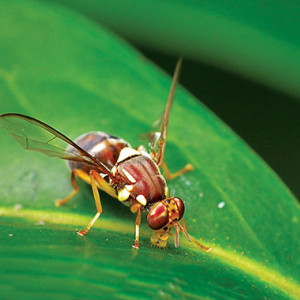Further biosecurity restrictions on the movement of fruit and vegetables in the Auckland suburb of Northcote are being put in place, following the find of a third Queensland fruit fly in the area.
The male fly was found in a surveillance trap just outside the A Zone controlled area, but within Zone B, and was around 270 metres away from the last detection in Northcote.
Biosecurity officials say it is disappointing they have found another fly, but the detection is showing the effectiveness of their surveillance programme.
Importantly, they still have no evidence of an established breeding population.
All 5,243 fruit fly traps in the greater Auckland area have now been checked. That includes 629 traps combined in the three controlled areas, which are being checked every day or every third day depending on the controlled area they are in.
Managing fruit and vegetable waste has also been a priority.
By February 28, Biosecurity New Zealand had disposed of more than five tonnes of waste that communities in the controlled zones have put in the disposal bins.
The detection means the restrictions on movement of fruit and vegetables in Zone A in Northcote, the 200m radius area around the original detection, will be extended towards the south-east to take account of the latest find. A detailed map of the controlled area and a full description of the new boundaries and movement controls is at biosecurity.govt.nz/fruitfly .
Biosecurity moreover is taking further measures to ensure it is doing everything it can sensibly do to find any other fruit flies in the area.
Because of the new find in Northcote, the response in Devonport will continue for another week rather than be closed at the weekend, which would be standard practice after no new finds in the suburb for a fortnight.
Biosecurity New Zealand will be establishing further enhanced fruit fly trapping between the Devonport and Northcote detections as a precautionary measure.
There will be no restrictions on the movement of fruit in these areas. This in-fill trapping is precautionary.
Biosecurity New Zealand is working with industry partners to put in place appropriate controls on the movement of fruit destined for export through or near Northcote.
This is designed to strengthen trading partner confidence in New Zealand’s response and risk management.
The measures being taken mean any fruit or vegetables that can host Queensland fruit fly, and which is destined for export, cannot come within a 3.2 kilometre radius of the Northcote detections, unless it is suitably pest-proofed – for example by shrink-wrapping pallets.
The volume of fruit impacted by this is expected to be very small at this time of the year and exporters can avoid these restrictions entirely by trucking produce along the more western routes 18 and 16.
Biosecurity New Zealand has put in place additional measures at the border to increase vigilance for the remainder of the Queensland fruit fly high-risk season, which is due to end at the end of April, and will be reviewed at that time. These include additional x-ray screening and baggage searches of arriving air passengers and further checks of cruise ships at regional ports after intensive inspections at the first port of arrival.
Meanwhile, Rob Delane, the Australian specialist who is undertaking the independent assurance review of the air passenger, cruise and mail pathways, has completed the first week of his review.
There have been no further detections of the facialis fruit fly in Ōtara.
Source: Ministry for Primary Industries












